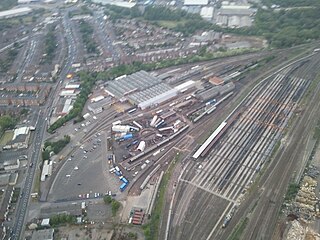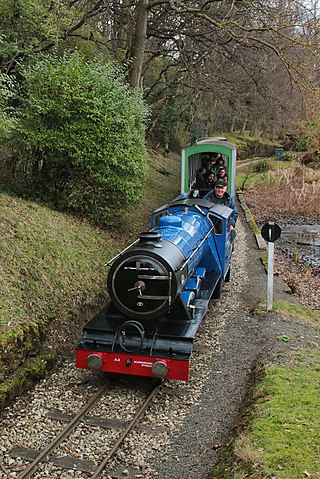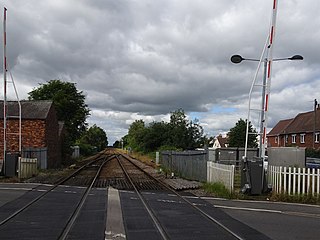Related Research Articles

The North Eastern Railway (NER) was an English railway company. It was incorporated in 1854 by the combination of several existing railway companies. Later, it was amalgamated with other railways to form the London and North Eastern Railway at the Grouping in 1923. Its main line survives to the present day as part of the East Coast Main Line between London and Edinburgh.

A motive power depot (MPD) or locomotive depot, or traction maintenance depot (TMD), is where locomotives are usually housed, repaired and maintained when not being used. They were originally known as "running sheds", "engine sheds" or, for short, just sheds. Facilities are provided for refuelling and replenishing water, lubricating oil and grease and, for steam engines, disposal of the ash. There are often workshops for day to day repairs and maintenance, although locomotive building and major overhauls are usually carried out in locomotive works.

Malton railway station is a Grade II listed station which serves the towns of Malton and Norton-on-Derwent in North Yorkshire, England. Situated on the York-Scarborough Line, it is operated by TransPennine Express, who provide all passenger train services. Once a former interchange between four lines, Malton station is now only served by trains operating between York and Scarborough. The station itself is south of the River Derwent, and is actually in the town of Norton in the East Riding of Yorkshire, which for many years was in a different county to Malton.

Pickering railway station is the southern terminus of the North Yorkshire Moors Railway and serves the town of Pickering in North Yorkshire, England. The first railway arrived in Pickering from the north in 1836, however, it wasn't until the railway was connected from the south in 1845, that the current station was built. The station was closed by British Railways in March 1965, but since 1975, the station has served as the southern terminus of the North York Moors Railway.

Tyseley TMD is a railway traction maintenance depot situated in Tyseley, Birmingham, England.

Gateshead TMD was a railway traction maintenance depot situated in Gateshead, England. The depot code was 52A during the steam era and GD later on.

Thornaby TMD was a railway traction maintenance depot situated in Thornaby, England, latterly operated by DB Schenker. The depot was situated to the east of Thornaby, on the northern side of the line to Middlesbrough.

Scarborough North Bay Railway (SNBR) is a ridable miniature railway in Scarborough, North Yorkshire, England. It was built in 1931, to the gauge of 20 in, and runs for approximately 7⁄8 mile (1.4 km) between Peasholm Park and Scalby Mills in the North Bay area of the town. The railway attracted approximately 200,000 visitors in the 2014–2015 season, and remains popular with tourists.

The NER 901 Class was a class of 2-4-0 steam locomotive of the North Eastern Railway, designed by Edward Fletcher. Between 1872 and 1882 55 of the class were built for the NER.
There were a number of engine sheds and railway works located in York. The large York North engine shed became the National Railway Museum in 1975.
Ken Hoole (1916–1988) was an English historian known for his works on the railways of the north east of England.
West Auckland railway station served the villages of St Helen Auckland and West Auckland in County Durham, England, between 1833 and 1962. It was on the railway line between Bishop Auckland and Barnard Castle. There was a locomotive depot, which was the only one to be both closed completely and later reopened by the London and North Eastern Railway.

The Thirsk and Malton line was a railway line that ran from a triangular junction on what is now the East Coast Main Line and served eight villages between Thirsk and Malton in North Yorkshire, England. The line was built after a protracted process due to inefficiencies and financial problems suffered by the then York and North Midland Railway.

Botanic Gardens TMD is a traction maintenance depot in Kingston upon Hull in Yorkshire, England. As built it was one of the principal steam engine sheds in the Hull area, Botanic Gardens was the one closest to the main Hull Paragon station and its locomotives were responsible for working passenger services in the area. This entry also covers the engine sheds in the Paragon area that preceded Botanic Gardens.
Wistow was the sole intermediate station of the short Cawood, Wistow and Selby Light Railway (CW&SLR), in rural North Yorkshire, England. The line was connected to the North Eastern Railway (NER) at its southern end.

Selby (Brayton Gates) was the initial, temporary southern terminus of the short Cawood, Wistow and Selby Light Railway (CW&SLR) in North Yorkshire, England. The line was connected to the North Eastern Railway (NER) nearby. The station is sometimes referred to as "Brayton Gates" or plain "Selby", though it was around a mile from the much larger Selby station.
Manningham Engine Shed was a railway depot located in the Manningham suburb of Bradford in West Yorkshire, England. The depot was built to provide steam engines for services leaving Bradford Forster Square station and freight traffic from the Valley Road area of the city. It was also responsible for other sites at Keighley and Ilkley with Manningham itself being a sub-shed of Holbeck.

Whitby engine shed was a steam locomotive depot located at the south end of Whitby railway station in North Yorkshire, England. The shed was opened in 1847, extended in the 1860s, and closed in 1959, when the closure of lines and dieselisation of the routes from Whitby took hold. The shed building, which was grade II listed in 1991, still stands, being utilised for various enterprises, and is now used as holiday accommodation.

Beckhole Incline was a steep, rope-worked gradient on the railway line between Whitby and Pickering, in the North Riding of Yorkshire, England. Opened in May 1836 as part of the horse-worked Whitby & Pickering Railway, the line was operated by three railway companies before becoming redundant on the opening of a diversionary line to the east that allowed through working by steam engines on the entire line. Although the incline was closed to regular traffic in 1865, it was used for a very brief period in 1872, to test a special locomotive intended for railways with steep gradients.
Malton engine shed was a steam locomotive depot located by Malton railway station in North Yorkshire, England. The depot opened in 1853 to provide locomotives for the increase in traffic around Malton with the opening of the lines to Driffield and Gilling. It was closed in 1963.
References
- ↑ "Disused Stations: Scarborough Londesborough Road Station". disused-stations.org.uk. Retrieved 29 September 2021.
- 1 2 3 Griffiths & Hooper 2020, p. 112.
- ↑ Addeyman 2020, p. 153.
- ↑ Hoole 1972, p. 196.
- ↑ Addeyman 2020, p. 156.
- 1 2 Addeyman 2020, p. 154.
- ↑ Hoole, K. (1986). The North East (3 ed.). Newton Abbot: David St John Thomas. p. 83. ISBN 0946537313.
- ↑ Hoole 1972, p. 197.
- ↑ Chapman 2008, p. 52.
- ↑ Addeyman 2020, p. 155.
- 1 2 Griffiths & Hooper 2020, p. 113.
- ↑ Bolger, Paul (1984). BR steam motive power depots, NER. London: I. Allan. p. 22. ISBN 0-7110-1362-4.
- ↑ Chapman 2008, p. 61.
- ↑ Chapman 2008, p. 60.
- ↑ Bolger, Paul (1984). BR steam motive power depots, NER. London: Ian Allan. p. 21. ISBN 0-7110-1362-4.
- ↑ Lidster, J. Robin (2014). Scarborough to Pickering Railway through time featuring the Forge Valley line. Stroud: Amberley Publishing. p. 15. ISBN 9781445618272.
- ↑ Hoole, K. (1977). Railways in Yorkshire. 3, North Riding. Clapham, N. Yorkshire: Dalesman. p. 13. ISBN 0-85206-418-7.
- ↑ Young, Alan (2015). The lost stations of Yorkshire; the North and East Ridings. Kettering: Silver Link. p. 126. ISBN 978-1-85794-453-2.
- ↑ Chapman 2008, p. 59.
- ↑ Fisher, Alex, ed. (2018). On Shed 4; North Eastern Region. Cudham: Kelsey Media. p. 67. ISBN 978-1-910554-85-2.
- ↑ "TPE considering revised Nova 3 deployment". Modern Railways. Vol. 78, no. 875. Stamford: Key Publishing. August 2021. p. 14. ISSN 0026-8356.
- ↑ "TOPS Depot Codes – Locomotives and Rolling Stock". rcts.org.uk. Retrieved 29 September 2021.
- ↑ Shannon, Paul (2019). British railway infrastructure since 1970 : an historical overview. Barnsley, South Yorkshire: Pen & Sword. p. 122. ISBN 978-1526734792.
- ↑ Fisher, Alex, ed. (2019). On Shed 8: A to Z of BR Diesel Depots. Cudham: Kelsey Media. p. 88. ISBN 978-1-913263-00-3.
- ↑ Coward, Andy, ed. (November 2021). "TPE's Scarborough Depot closes overnight". Railways Illustrated. Horncastle: Mortons Media. p. 9. ISSN 1479-2230.
- ↑ Numminen, Anttoni James (1 May 2023). "Train firm sorry after residents brand depot noise 'unbearable'". The Yorkshire Post. p. 2. ISSN 0963-1496.
- ↑ Bond, Chris (15 May 2021). "Line of Duty". The Yorkshire Post. The Magazine. pp. 8–10. ISSN 0963-1496.
- ↑ Padgett, David (2016). Railway track diagrams. Book 2, Eastern. Beckington, Frome: Trackmaps (Firm). 19E. ISBN 978-0-9549866-8-1.
Sources
- Addeyman, John F, ed. (2020). North Eastern Railway Engine Sheds. North Eastern Railway Association. ISBN 978-1-911360-26-1.
- Chapman, Stephen (2008). York to Scarborough, Whitby & Ryedale. Todmorden: Bellcode Books. ISBN 9781871233193.
- Griffiths, Roger; Hooper, John (February 2020). "Scarborough Engine Shed and its Locomotives". Backtrack Magazine. Vol. 34, no. 2. Easingwold: Pendragon. ISSN 0955-5382.
- Hoole, K. (1972). North Eastern locomotive sheds. Newton Abbot: David and Charles. ISBN 0-7153-5323-3.